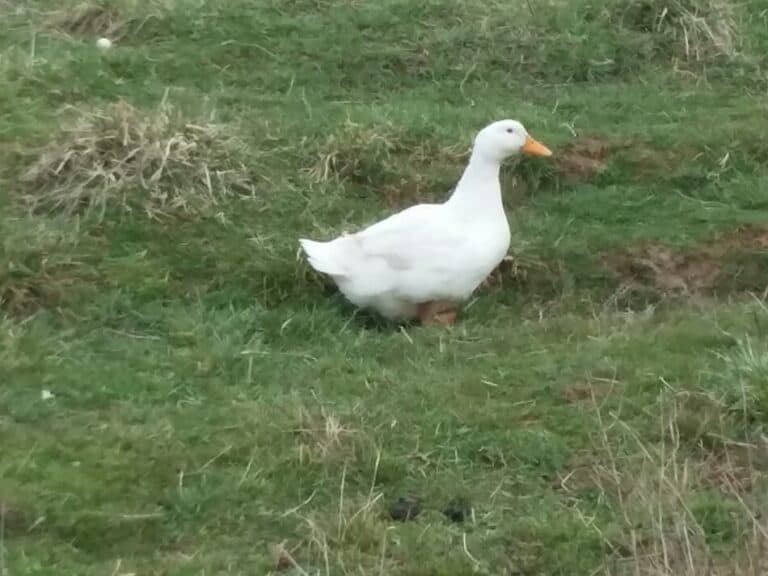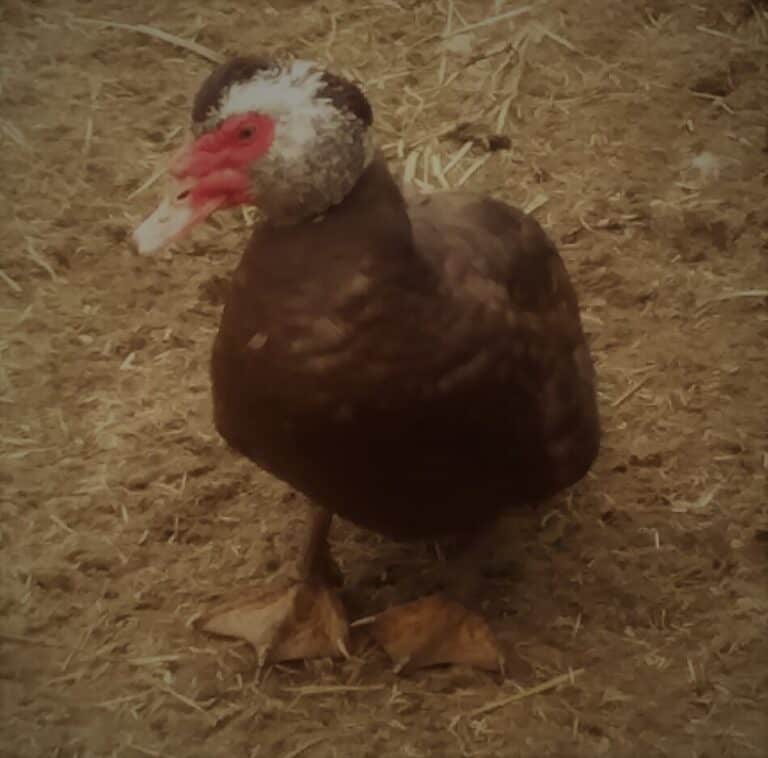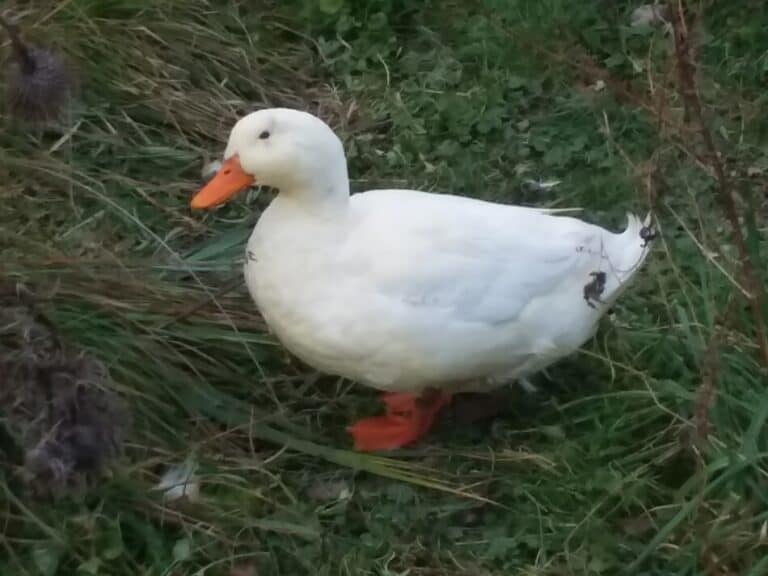Do Ducklings Need A Heat Lamp?

I love ducklings, they are one of the best parts of spring! To keep your ducklings happy and help them to grow their best, chances are you’ll need to provide supplemental heat.
How long do ducklings need the heat and how can you tell when they are big enough to go without supplemental heat?
Ducklings need supplemental heat until they are 6 weeks old or fully feathered.
If you purchased day old ducklings from a hatchery, you’ll need to have a heated brooder ready for them to keep them warm and safe.
Plan on the ducklings staying in the heated brooder for at least a few weeks, depending upon the temperature and weather.
Is Raising Your Own Ducks Worth It? is an article I wrote covering all of the costs involved in raising ducklings, check it out for the details.
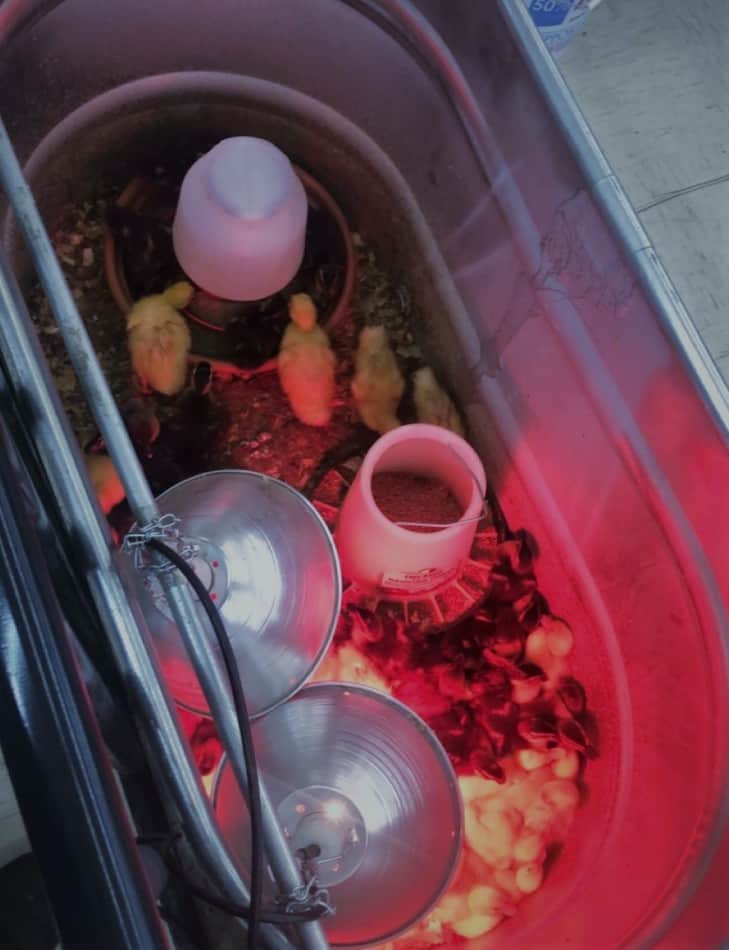
Start ducklings in a heated brooder
Your ducklings will need to be raised with supplemental heat for the first few weeks of their life.
You can use heat lamps or a brooder plate as the heat source, but all ducklings require supplemental heat.
The ideal temperature in your brooder for newly hatched ducklings is 90 degrees. Close to 90 is fine, but keep it within a few degrees.
If you are using heat lamps, grab a thermometer and see what the temperature is at ground level.
If you are getting an area of 90 degrees that is big enough for all of the ducklings to fit in the heated area, you are all set.
If you need more room, grab another heat lamp or two.
We always set up at least two lamps, this way there is plenty of room in the heated zone for all of the ducklings to fit without crowding and the ducklings have a choice of where to hang out.
Ducklings will outgrow the need for heat by 6 weeks
| Age of ducklings | Temperature | Brooder heat needed |
| Day old ducklings | 90 degrees | Yes |
| 1 week old | 85 degrees | Yes |
| 2 weeks old | 80 degrees | Yes |
| 3 weeks old | 75 degrees | Likely |
| 4 weeks old | 70 degrees | Likely |
| 5 weeks old | 65 degrees | Maybe |
| 6 weeks old | 60 degrees | Probably not |
| 7+ weeks | 55 degrees | No |
By the time your ducklings are around six weeks old they will not need heat any more, no matter the time of year you are raising them.
Here’s a great overview article on rearing ducklings, Brooding and Rearing Ducklings from Missouri State Extension.
By 6 weeks your ducklings will have all of their feathers and be looking more like adults. They might not be full grown yet, but they definitely aren’t babies anymore!
If you are raising Pekins, they will be close to full size by this age, (market size is 7 weeks for these guys), way past the need for supplemental heat!
For Pekin duck raisers, read my article Cost Of Raising Pekin Ducks. This article goes into the cost of raising Pekin ducklings from newly hatched to 8 weeks.
During unusually cold weather, keep the heat on the ducklings
However, use common sense here and watch the ducklings’ behavior.
Think of it this way, if you are out in your winter coat taking care of your ducklings, it’s too cold to turn off the lamp!
It doesn’t matter how old the ducklings are, as long as the weather is unusually cold, keep the supplemental heat on.
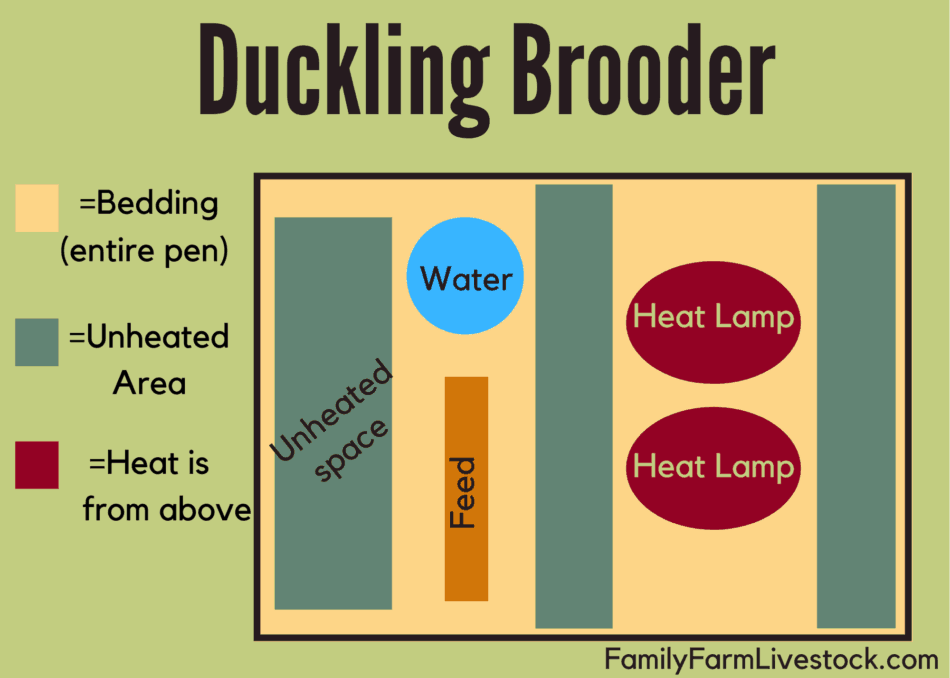
All newly hatched ducklings need heat
Any hatchling needs supplemental heat, even if it is hot out when you get them.
Your brooder set up should have heated areas and unheated areas.
Make sure the ducklings can move freely between heated areas of the brooder and non heated areas.
The easiest way to do this is to keep the food and water out in the open areas, away from the heat.
Keep the area under the heat lamp for hanging out or sleeping.
The ducklings will quickly learn to zoom out and get food and water then come back to the heated area when it suits them.
Two week old ducklings will still need supplemental heat
By the time your ducklings are two weeks old, you will have seen quite a bit of growth, but they will still need supplemental heat.
True, not as much heat as when they were hatchlings, but they still need some heat.
If you want to start using less heat on these guys, start moving the lamp up in the pen during the day and putting it back in place for the evening.
Or you can turn it off in the hot parts of the day and just run the heat lamp overnight.
Until you see that the ducklings are usually not using the heat lamp, keep it available to them.
Four week old ducklings might need heat
At four weeks old, we are getting to the age where your ducklings may not need heat at all.
Whether or not you can stop providing heat to the ducklings completely depends upon the weather in your area.
At the very least, you should be able to turn off the heat during the warmest parts of the day, but turn on the lamp again when the temperatures start to fall for the evening.
Ducklings still need a heat lamp in summer
It may sound a bit crazy, but your newly hatched ducklings still need a heat lamp in the summer.
Even if the temperatures in the day are 90 or higher, the ducklings need to stay at 90 degrees all of the time. This means a heat lamp.
To make sure the ducklings stay comfortable, keep an eye on them in the heat. Check them frequently to make sure they are not too hot.
Here’s a tip: if you are sitting in your AC, saying “it’s way too hot to go out there”, you need to check the ducklings ASAP.
Heat duckling brood with heat lamp or brooder plate
I have to admit, we have only ever used heat lamps to brood young poultry, ducks included.
I have seen the newer style brooder plates and have heard good things about them, but have no experience with them myself.
Mainly because the brooder plates are recommended for 20 new babies, we usually have bigger batches than that.
Which ever heat source you choose to use, have a back up plan. Usually, this is just extra bulbs for the lamps.
Also, have a way to plug in multiple heat lamps, in case the temperatures drop unexpectedly.

Determine if ducklings are too hot or too cold
Actually, it’s pretty easy to tell if ducklings are too hot or too cold. You just need to look at where they sit in relationship to the heat.
Ducklings avoid overly warm areas
Ducklings that are too hot: If your ducklings are too hot they will be avoiding the circle of light under the heat lamp.
The hotter they are, the more they are trying to distance themselves from the heat.
The fix here is to take away a light or just turn it off for the day and see how they react.
Be careful here, do not turn off all of the lights, just one. If you only have one light, make the pen bigger and/or raise the lamp.
If you notice they are too hot, yet you feel they can not go without a light, try raising the light. This will make it slightly less warm under the lamp, yet still provide heat for the ducklings.
Ducklings will huddle or pile in the cold
Ducklings that are too cold: If your ducklings are too cold they will be piling on top of one another to try to get under the heat to stay warm.
Not only does this mean they are not warm enough, it also means you are likely to find crushed ducklings on the bottom of the pile, yikes!
The easy fix here is to add another lamp.
We have noticed that when it is really cold, a tarp or big sheet of plastic over the whole brooder will keep in more heat.
Additionally, you can partially enclose the heated area to keep in more heat.
However, be cautious here. The ducklings must be able to move freely in and out of the heated area and must not be scared to go into it.
Plentiful bedding helps ducklings stay warm
Keeping plenty of dry bedding in the duck pen will help to keep the ducklings warm and comfortable.
Bedding does not replace the need for supplemental heat! The bedding just helps the brooder stay more comfortable for the ducklings with the added heat.
Keeping the bedding dry is a challenge. Ducks of all ages are masters at making messes with water!
The problem comes with sloshing out all of the water on to the bedding and now that part of the pen is wet and will be cold.
Do your best here, keep replacing the bedding around the waterers as needed.
If you haven’t done so already, move the waterer out of the heated area to help keep the heated area dry.
